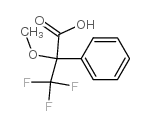| 结构式 | 名称/CAS号 | 全部文献 |
|---|---|---|
 |
(S)-(-)-α-甲氧基-α-(三氟甲基)苯乙酸
CAS:17257-71-5 |
|
 |
α-甲氧基-α-(三氟甲基)苯乙酸
CAS:56135-03-6 |
|
 |
(R)-(+)-α-甲氧基-α-(三氟甲基)苯乙酸
CAS:20445-31-2 |